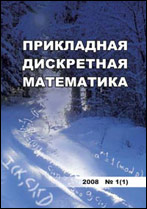|
This article is cited in 12 scientific papers (total in 12 papers)
Mathematical Methods of Cryptography
Substitution block ciphers with functional keys
G. P. Agibalov
National Research Tomsk State University, Tomsk, Russia
Abstract:
We define a substitution block cipher $\mathcal C$ with the plaintext and ciphertext blocks in $\mathbb F_2^n$ and with the keyspace $K_{s_0,n}(g)$ that is the set $\{f(x)\colon f(x)=\pi_2(g^{\sigma_2}(\pi_1(x^{\sigma_1})));\ \sigma_1,\sigma_2\in\mathbb F_2^n;\ \pi_1,\pi_2\in S_n\}$, where $s_0$ is an integer, $1\leq s_0\leq n$; $g\colon\mathbb F_2^n\to\mathbb F_2^n$ is a bijective vector function $g(x)=g_1(x)g_2(x)\dots g_n(x)$ such that every its coordinate function $g_i(x)$ essentially depends on some $s_i\leq s_0$ variables in the string $x=x_1x_2\dots x_n$; $S_n$ is the set of all permutations of the row $(1\ 2\dots n)$; $\pi_i$ and $\sigma_i$ are the permutation and negation operations, that is, $(\pi=(i_1i_2\dots i_n))\Rightarrow(\pi(a_1a_2\dots a_n)=a_{i_1}a_{i_2}\dots a_{i_n})$, $(\sigma=b_1b_2\dots b_n)\Rightarrow((a_1a_2\dots a_n)^\sigma=a_1^{b_1}a_2^{b_2}\dots a_n^{b_n})$ and, for $a$ and $b$ in $\mathbb F_2$, $a^b=a$ if $b=1$ and $a^b=\neg a$ if $b=0$. Like $g$, any key $f$ in $K_{s_0,n}(g)$ is a bijection on $\mathbb F_2^n$, $f(x)=f_1(x)f_2(x)\dots f_n(x)$, and every its coordinate function $f_i(x)$ essentially depends on not more than $s_0$ variables in $x$. The encryption of a plaintext block $x$ and the decryption of a ciphertext block $y$ on the key $f$ are defined in $\mathcal C$ as follows: $y=f(x)$ and $x=f^{-1}(y)$. Here, we suggest a known plaintext attack on $\mathcal C$ with the threat of discovering the key $f$ that was used. Let $P_1,P_2,\dots,P_m$ be some blocks of a plaintext, $C_1,C_2,\dots,C_m$ be the corresponding blocks of a ciphertext, i.e., $C_l=f(P_l)$ for $l=1,2,\dots,m$, and $P_l=P_{l1}P_{l2}\dots P_{ln}$, $C_l=C_{l1}C_{l2}\dots C_{ln}$. The object is to determine the coordinate function $f_i(x)$ of $f$ for each $i\in\{1,2,\dots,n\}$. The suggested attack consists of two steps, namely we first determine the essential variables $x_{i_1},\dots,x_{i_s}$ of $f_i(x)$ and then compute a Boolean function $h(x_{i_1},\dots,x_{i_s})$ such that $h(a_{i_1},\dots,a_{i_s})=f_i(a_1,\dots,a_n)$ for all $n$-tuples $(a_1a_2\dots a_n)\in\mathbb F_2^n$. For determining the essential variables of $f_i$, we construct a Boolean matrix $\|\inf D(f_i)\|$ with the set of rows $\inf D(f_i)$, where $D(f_i)=\{P_l\oplus P_j\colon C_{li}\neq C_{ji};\ l,j =1,2,\dots,m\}$, $C_{li}=f_i(P_l)$, $l=1,\dots,m$, $i=1,\dots,n$, and $\inf D(f_i)$ is the subset of all the minimal vectors in $D(f_i)$. Then the numbers of essential variables for $f_i$ are the numbers of columns in the intersection of all covers of $\|\inf D(f_i)\|$ with the cardinalities not more than $s_0$, where a cover of a Boolean matrix $M$ is defined as a subset $C$ of its columns such that each row in $M$ has '1' in a column in $C$. For computing $h(x_{i_1},\dots,x_{i_s})$, we first set $h(P_{li_1},\dots,P_{li_s})=C_{li}$ for $l=1,\dots,m$ and then, if $h_i$ is not yet completely determined on $\mathbb F_2^s$, we increase the number $m$ of known blocks $(P_i,C_i)$ of plain- and ciphertexts or extend $h_i$ on $\mathbb F_2^s$ in such a way that the vector function $h=h_1h_2\dots h_n$ with the completely defined coordinate functions is a bijection on $\mathbb F_2^n$. We also describe some special known plaintext attacks on substitution block ciphers with keyspaces being subsets of $K_{s_0,n}(g)$.
Keywords:
substitution ciphers, block ciphers, functional keys, cryptanalysis, known plaintext attack, Boolean functions, essential variables, bijective functions.
Citation:
G. P. Agibalov, “Substitution block ciphers with functional keys”, Prikl. Diskr. Mat., 2017, no. 38, 57–65
Linking options:
https://www.mathnet.ru/eng/pdm598 https://www.mathnet.ru/eng/pdm/y2017/i4/p57
|

| Statistics & downloads: |
| Abstract page: | 303 | | Full-text PDF : | 111 | | References: | 54 |
|




 Contact us:
Contact us: Terms of Use
Terms of Use
 Registration to the website
Registration to the website Logotypes
Logotypes








 Citation in format
Citation in format 
